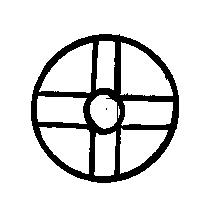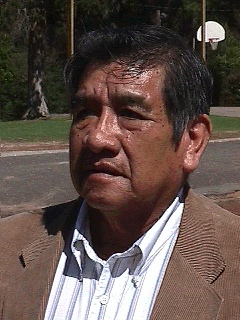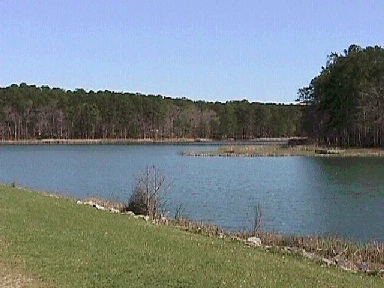 The
Great Spirit had bestowed upon man the priceless gift of free will of which
each individual makes his own choice between "good" and "evil"
- this is a fundamental teaching of the Alabama-Coushatta.
The
Great Spirit had bestowed upon man the priceless gift of free will of which
each individual makes his own choice between "good" and "evil"
- this is a fundamental teaching of the Alabama-Coushatta.
This symbol of the twin water-fowls
represents the Alabama-Coushatta Tribes. The Creator is symbolized by what
has come to be called the egg, the seed, or the cell.
The four diamond-shaped symbols
issuing from the mouth means the four elements: air, fire, water, and earth
- all which make life possible. Yet, from the last one, a sprout emerges
signifying a new beginning. The design symbolizes the four directions,
the four seasons, the four phases of man, and all things appearing in multiples
of four.
This symbol also represents the Twin Manifestations, or the two wise ones
to come, as foretold in the many legends of North, South, and Central American
Indian cultures that will unite the people as one.
The Twin Manifestations are also
viewed as the positive and negative elements: day and night, sky and earth,
life and death. Each is seen as apart of the necessary rhythm of the Circle
of Life as it is known throughout creation.
The seven feathers and black points
on either side are a representation of the seven sacred fires and the seven
ceremonial pipes. Seven times seven is forty-nine, at which time a man
or woman is recognized, after having survived all tests and difficulties
and proven through deed the wisdom of his or her spiritual power.
These are two tribes
that combined to live together, the Alabama tribe and the Coushatta tribe.
Neither tribe is originally from Texas. Both are from the Southeast --
Alabama, Mississippi and Georgia. The Alabama are one tribe from Alabama
and the Coushatta are another. Both were forced to move to Texas. The Alabama
are a subtribe of the Creek Indian tribe, so anything you can find on the
Creeks will be useful to you. The Creeks were, and still are, a large and
important tribe. The Creek tribe was formed from the survivors of the many
mound building tribes who lived in the Southeast United States. The Creek
Indians are one of the five "civilized tribes" from the Southeast
who now live in Oklahoma.
The record of the first
contact with the Alabama comes from the De Soto expedition in 1641. Desoto
found the "Alibamo" tribe in central Mississippi and attacked
a killed many of them in a fierce battle. Later they moved east into present
day Alabama where they lived at the junction of the Coosa and Tallapoosa
rivers. DeSoto also found the Coushata living on the Tennessee river. By
the 1780s the Americans wanted the land in Alabama and the Alabama were
forced to move west across the Mississippi river into Louisiana around
Opelousa. Around 1803 they moved west again into across the Sabine river
into Northeast Texas. They were settled in the region of the Hasinais Caddo
Indians where they still live today. In 1858 they were given 1280 acres
of land where their reservation is today. In 1955 the Federal Government
turned the administration of the reservation over to the State of Texas.
So, this is not an official reservation like other Indians have.
The Alabama Coushatta
are a culture of farmers who live in villages. Before contact with Europeans,
they lived in Indian style houses in large villages. By historical times,
1700-1900, they lived in European style houses on European style farms.
They were very much like the Caddo and the other Southeastern Indian tribes.
Look for info about the Caddo, Creeks, Cherokees, or other southern Indians.
The Alabama-Coushatta
are both part of the Southeastern Mound Building cultures. These cultures
include the Creeks, Cherokees, Caddo, Natchez, Choctaw, Muscogee and others.
All of these tribes shared a common religion. Each tribe had its own traditions
and way of observing this religion. But the basic beliefs, ceremonies and
traditions are basically the same.
They built huge temple
mounds of dirt. These were like pyramids. On top they would place a temple
or the house of a priest or chief. There are thousands of these mounds
all over the southern US. In Texas the Caddo built mounds. You can visit
Indian Mounds State Park near Alto and see some of them.
Fire was an important
part of their religious tradition. Each house kept a sacred fire going
all the time. At the main temple there was also a fire that burned all
the time. These fires were built a special way. They would place four logs
in the shape of a cross around the central fire. One log would point north,
one east, one south and one west. As the fire burned the ends of these
logs the people would push them in to the center. A home fire would have
small logs and a dance ground, would have big logs to last longer. Fire
was believed to be a part of the sun and the sun represented the highest
God. Here is the Southeastern Indian symbol for fire and the sun.

The arms are the logs
and the small circle in the middle is the fire.
For food these Indians
farmed corn, beans, squash and other crops. They would also hunt deer and
gather berries, roots, and nuts. They used bows and arrows to hunt larger
animals in the forests like deer. One favorite food was bear. Bear meat
must be very good to eat because the Indians and Europeans seemed to have
liked it more than deer or beef when they could get it. To hunt smaller
animals like birds and rabbits they used blow guns made from long lengths
of cane.
They did things to make
hunting easier in the woods around where they lived and farmed. Early European
explorers reported finding the woods cleared like a European park. This
means the grass was short and the undergrowth was cleared away. The Indians
did not have tractors or lawn mowers to do this. They would set fires in
the woods to burn away the old taller grass and small shrubs and bushes
without hurting the old trees with thick bark. If this is done every year
or so, the fire keeps the undergrowth out. The Indians would do this in
the fall and winter. In the spring new green grass would get more sun and
grow better on the burned areas than in undergrowth. This tender green
grass would attract deer and animals to hunt. These fires also made it
easier to find acorns and nuts on the ground. The Southeastern Indians
used a lot of acorns for food. So these fires were useful and not destructive.
This is one way the Indians controlled their environment. Here is a Myth
about how the Indians got fire.
"When Bear Lost Fire"
from Texas Indian Myths and Legends
by Jane Archer, Wordware Publishing
Bear roamed through thick forests,
eating sweet honey from bee hives, fishing in rushing streams, and sleeping
through long winters in deep, warm caves. Strong and powerful, Bear owned
Fire.
Bear carried Fire everywhere, but one day Bear grew distracted by an abundance
of tasty acorns. Bear set Fire on the ground, then gobbled up acorns with
no thought to Fire.
Soon Fire burned low and grew afraid, for Bear moved farther away under
ancient trees, tossing acorns into massive jaws.
"Help me!" Fire tried to burn brighter but with no success.
Bear didn't hear, having spotted a beehive. Thoughts of a thick yellow
comb dripping with sticky sweetness danced in Bear's head. Copyright, 2000,
Jane Archer
"Feed me!" Fire called desperately, almost extinguished from
lack of fuel.
The people gathered pecans under nearby trees. They heard Fire cry out,
but they knew it was dangerous to go near Bear who owned Fire. Still they
could not ignore the helpless cries.
"What do you eat?" the people asked.
"Wood. I need wood."
The people quickly gathered a piece of wood from each direction, then returned.
They laid a stick across Fire toward the north. They laid a stick across
Fire toward the west. They laid a stick across Fire toward the south. They
laid a stick across Fire toward the east. And finally Fire blazed up.
"You saved me." Fire burned brightly.
A loud roar came from under the oak trees, and Bear rushed into the clearing.
The people scattered in all directions, dropping their baskets of pecans.
Bear reached down to take back Fire but jerked away, burned for the first
time.
"Go away," Fire said. "You forgot me so I no longer know
you."
Bear rose up high on two legs, growling and whining, but to no avail. Fire
no longer knew Bear, so the mighty beast lumbered unhappily away with no
interest in acorns or honey now.
"Come get me," Fire called to the people. "If you take care
of me, I will take care of you."
And the People came for Fire.
Copyright, 2000 Jane Archer
If you enjoyed this myth, read more
in Texas Indian Myths
and Legends by Jane Archer.
Ask your librarian to order Texas Indian Myths and Legends for your
school.
Did you like that myth? Now that you
know about the Alabama-Coushatta and their religion and traditions about
fire do you see these things in the myth? To learn more about Indian myths
and for activities using myths check out our Indian Myths page.

This is Chief Clayton Sylestine, 1999.
He is an Alabama Indian, but is Chief of both tribes. He is a retired forestry
technician. I asked him, "what would you like to say to people outside
the reservation, what would you like them to know"? He answered.
"I would like people to see the
Alabama-Coushatta as human beings, not the savages on TV and the movies.
We are just like everyone else in the modern world. I would also like people
to know we are not Plains Indians, we never lived in tee-pees. We had log
cabins and huts. We were farmers and hunters."
I then asked, "what is the most
important thing for your people today"? He answered,
"We need to emphasize education
from elementary to college for our young people. We are trying to save
the old language. We want the young people to learn to speak Alabama or
Coushatta. Too many of them are growing up with only English".
The Alabama-Coushatta are one of three
Federally recognized Indian tribes in Texas. The Alabama-Coushatta live
today on 2800 acres of tribally owned land in east Texas near Livingston.
There are 1100 enrolled members of the tribe and about 500 of them live
on and around the land. This land used to be part of a reservation. But,
the Government dissolved the reservation many years ago. They have a visitor
center that is open in the summer and a campground.

This is the lake next to the campground.
The reservation is a very beautiful place. The Alabama-Coushatta have nature
tours of the reservation.
By the President
of the Republic of Texas (1839)
Whereas, it has been made known to the Executive that serious disturbances
and conflicts have recently taken place between the Cushatta Indians and
some of the citizens of the Republic residing in the neighborhood of their
Towns and Villages on the Trinity River, in which five of the Indians have
been slain, and the residue (as it is said) threatened with extermination.
And Whereas, it has
also been represented to the Executive that the said Cushatta tribe of
Indians are, and always have been, peaceful and friendly disposed towards
the white settlers of the country, and are desirous of living upon terms
of amity with all the good Citizens of this Republic, if permitted to do
so.
And Whereas, such
disturbances and conflicts if kept up, will involve the Nation in a war
with every Indian tribe now within its borders, and prevent the carrying
out that system of policy which has been adopted and is now in progress
for the termination of the difficulties with which the Country has been
so long harassed, by the removal of all Indians having no rightful claim
to the soil of Texas, beyond her Territorial limits.
Therefore be it known
that I, Mirabeau B. Lamar, President of said Republic, do by virtue of
the power and authority invested in one by law, issue this my Proclamation,
requesting and strictly enjoining the Citizens of this Republic to abstain
from all and every act of hostility towards said Indian tribe not required
for the immediate preservation of themselves and property. And I do hereby
invoke the said Citizens to make known to their Government through the
agent appointed to superintend the affairs of said tribe, all causes of
complaint which now exist, or may hereafter arise in respect to the said
Indians before proceeding to hostilities with said tribe. And to preserve
peace, and to prevent future violations of the Law, I do hereby strictly
require and enjoin it upon all Officers of this Republic, Civil and Military,
to be vigilent in suppressing all acts of hostility between Citizens of
the same, and the said Indian tribe; and to use all proper and lawful means
for the dispersing of any armed bands or parties which may assemble for
the purpose of violating these laws, and involving the Country in war and
bloodshed.
Given under my hand
and the seal of the Republic at Houston, this ninth day of July, eighteen
hundred and thirty nine, and of the Independence of Texas the Fourth year
Mirabeau B. Lamar
[President of Texas]
"President Sam
Houston's plans for the Indian population provided for peace, friendship,
trade, and frontier protection. Mirabeau B. Lamar, who succeeded Houston
as president, adopted a program that included exterminating the hostile
tribes and removing friendly tribes from the republic or moving them to
reservations in Texas. It is remarkable that Lamar's harsh policy was not
applied to the Alabamas and Coushattas. While all other East Texas tribes
were removed, Lamar expressed friendship toward these two tribes, requested
white settlers in the Trinity River area to respect their rights, and appointed
an agent to assist them in their relations with their neighbors. Furthermore,
in 1840—during Lamar's administration—the Republic of Texas Congress
granted each of these two tribes two leagues of land. " (Howard N.
Martin, "ALABAMA-COUSHATTA INDIANS," Handbook of Texas Online
)
| For you younger readers, there were many laws
and customs in the 1890s and later that discriminated against what were
called "persons of color" or colored persons. Persons of color
were Africans, Mexicans, Chinese and of course Indians. Of course the term
colored means their skin was not white. There were laws back then called
Jim Crow laws that banned colored persons from sitting in or eating in
white only restaurants. Persons of color were not allowed in the city limits
of many towns after dark. Businesses could refuse to do business with them
and did so. In some places Jim Crow laws required persons of color to always
be employed or be sent to prison to work on convict labor gangs. Persons
of color or "coloreds' as they were called by whites were not allowed
to vote, could not hold elected office, and were not allowed to sue or
use the court system. Their children had to go to substandard colored schools
and often had no schools. Many jobs and professions were forbidden to coloreds.
Most colleges in the south refused colored students by law. In most towns
they had to live in colored sections of town and could not buy or live
in white only parts of town. So, if an Indian could pass as being white
they did. Many did not want to enroll and come under the Jim Crow laws. |
Some names in "Albammo Kosati"
language
Alabama : Albaamo :: Coushatta
Kosaati
Arrow : taki, achsooka :: Arrow
head : Taki halokpa
Bal l : Pokko :: Baseball :
Pokkobatka :: Football : Pokkochobal :: Soccer : hatika,
pokkohatilka
Beans : Chastoki
Bear : Nita
Beautiful : Ilhicha
Bee : Foho
Bird : Foosi
Black : Lochachi
Buffalo : Yanasa
Butterfly : Hakchoopaalpa
Canoe : Pitta
Cat : Kati
Chief : Mikkotilka
Clay : Okti
Clothing : Ilokfa :: Skirt :
Hombayka
Cloud : Onoolichi
Corn : Chassi :: Corn dance
: Chassibitka
Coyote : Ifamatatli
Dance : Bitka
Deer : Icho
Dog : Ifa :: Puppy : Ifosi
Drummer : Bokokobaati
Eagle : Talaktochoba
Fart : Holikcho
Feather : Foosiwoksi
Fire : Tiba
Flower : Pakaali
Friend : Okla
Four-footed beings : Naasi iyyiostaaka
Frog : Hanono
Green corn : Chassokchaako
Horse : Chichoba
Indian : Aati
Knife : Talkoosa
Elephant : Aatipachoba (Yes
they now have a name for elephants now)
Lion : Kowichokchoki
Merry Christmas : Kilismi (Yes,
they have a name for that.) Say it out loud.
Owl : Opa
Spider : Hanchoklala
Raccoon : Sawa
Rattle : Iskataahachaabi
Rattlesnake :Chintochoba
Texas : Stulka teksi
Thunderbird : Kolkohkafoosi
War dance : Ittibafabirka
Woodpecker : Hiplichi